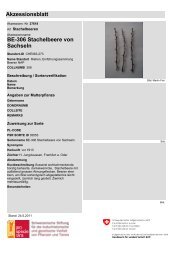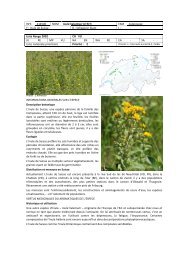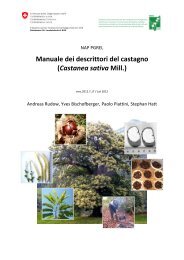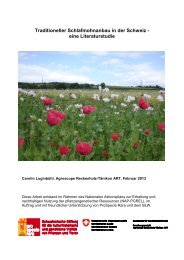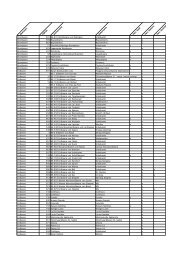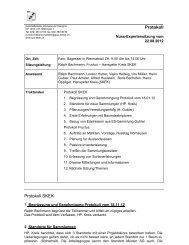Schlussbericht Crop Wild Relative
Schlussbericht Crop Wild Relative
Schlussbericht Crop Wild Relative
- TAGS
- schlussbericht
- crop
- wild
- relative
- bdn.ch
Sie wollen auch ein ePaper? Erhöhen Sie die Reichweite Ihrer Titel.
YUMPU macht aus Druck-PDFs automatisch weboptimierte ePaper, die Google liebt.
<strong>Crop</strong> <strong>Wild</strong> <strong>Relative</strong> Case Study 4<br />
Avena strigosa (Schreb.) in North-Western Europe:<br />
a historical landrace without crop wild relatives?<br />
M. Scholten 1 , W. Podyma 2 and E. Bettencourt 3<br />
1 2 3<br />
University of Birmingham, UK, Ministry of Agriculture and Rural Development, Poland, Estação Agronómica Nacional — INIAP, Portugal<br />
Photography M. Scholten Map adapted from Preston et al. 2002 New Atlas of the British and Irish Flora<br />
A. strigosa has been used in the past in Scotland<br />
both for human consumption, as fodder<br />
for horses and cattle, and the straw for furniture<br />
and thatching. The photograph above shows<br />
one current use on the Outer Hebrides as feed<br />
for Highland cattle. On the Shetland Islands<br />
the straw is still used to make chairs. It is usually<br />
grown as a mixed stand (with rye) to safeguard<br />
a harvest in dry years. Traditionally it was stored<br />
outside the farm in stacks (below).<br />
Avena strigosa: crop and crop<br />
wild relative<br />
Avena strigosa, an annual cereal, is both a minor,<br />
neglected crop and a crop wild relative. It<br />
is a diploid oat.<br />
As a crop it was domesticated in southern<br />
Europe, probably Spain and spread from there<br />
over Europe where it was cultivated before the<br />
more productive hexaploid oat (Avena sativa)<br />
made its entry.<br />
A. strigosa does not form a seedbank, it requires<br />
continuous reintroduction. Hence, without<br />
the crop, there will be no crop wild relatives.<br />
This is currently the case in many European<br />
countries where cultivation has ceased,<br />
for example in a wide survey in Denmark, former<br />
stronghold of the crop, not one plant was<br />
discovered (Weibull, 2001).<br />
The fate of not-native crop wild<br />
relatives: the example of the UK<br />
PGR Forum<br />
European <strong>Crop</strong> <strong>Wild</strong> <strong>Relative</strong> Diversity Assessment<br />
and Conservation Forum<br />
Plants associated with arable and horticultural<br />
habitats have undergone the strongest decline<br />
compared with plants in other habitats in the<br />
UK. Many crop wild relatives associated with<br />
former crops only occur as rare casuals nowadays.<br />
The plight of these plants, many of which not<br />
native to the UK, has recently been recognised<br />
by UK conservation authorities in the latest national<br />
Red Listing. “Archaeophytes”, that is,<br />
not-native plants that have arrived in the UK<br />
before 1500, have been included in the National<br />
Red List 2005 and as a consequence will<br />
be candidates for Biodiversity Action Plans.



